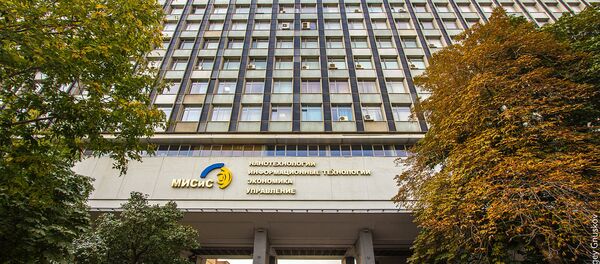The universities include the Moscow Institute of Physics and Technology, the National University of Science and Technology MISIS (NUST MISIS), the Higher School of Economics, the National Research Nuclear University (MEPhI), Novosibirsk State University and Saint Petersburg State University of Information Technologies, Mechanics and Optics (ITMO University).
In 2017, 11 universities made it into the top 100 specialized rankings by leading rating agencies (ARWU, QS and THE), including six universities involved in the Project 5-100. This includes the Moscow Institute of Physics and Technology, the National University of Science and Technology MISIS (NUST MISIS), the Higher School of Economics, the National Research Nuclear University (MEPhI), Novosibirsk State University and Saint Petersburg State University of Information Technologies, Mechanics and Optics (ITMO University).
The process of obtaining new scientific knowledge and creating cutting-edge technology is rather time-consuming. It is necessary to build new laboratories and to hire leading world-class scientists, to create favorable working conditions for them and to purchase sophisticated equipment. Five years after the program was launched, it appears that employees and students of Russian universities have made a clear contribution to the work of international research and development collaborations.
“For us, this Project 5-100 has paved the way to the future,” said NUST MISIS Deputy Rector for Science and Innovations Mikhail Filonov. “Instead of squandering this funding, we are spending it on development. Unlike any other federal programs, the 5-100 program makes it possible to purchase equipment, to invite any leading scientist and to build new laboratories. In addition, this program’s allocations make it possible to develop our own research plans and to correlate it with the global agenda. This program accounts for about 70 percent of our top-level publications that make NUST MISIS stand out, and our new laboratories are the driving force of the entire Russian science. We have already made it into the top 100 in metallurgy and mining and the top 200 in materials science. As we see it, these growth rates are something unprecedented for the research establishment,” he added.
What research achievements make scientists and administrators of universities supported by the Project 5-100 so confident that the program is cost- effective?
Global achievements involving scientists of Russian universities with the support of the Project 5-100
How to Recount microRNA
Subsequent research made it possible to find about 300 microRNA molecules and identify some of their functions.
This Nature Research Collection brings together research articles, analyses and resource papers from FANTOM5 https://t.co/VSGs6ax4fH pic.twitter.com/yUU24U29Vz
— nature (@nature) 7 сентября 2017 г.
According to scientists, microRNA studies are complicated by the fact that these molecules “work” only in living cells, and only in certain cells. Therefore it is very hard to identify their structure and role by merely using computers and genome-sequencing equipment.
“The creation of a complete atlas of microRNAs contained inside various cells has allowed us to better understand the entire gene-regulation process,” said project coauthor Yulia Medvedeva, a molecular biologist with the Russian Academy of Sciences’ Bioengineering Center and the Moscow Institute of Physics and Technology.
For example, biologists have noticed in the past five years that microRNA malfunctions are responsible for the “voices” plaguing people with schizophrenia. And they have also discovered their role in causing cancer, diabetes and many other serious diseases. It is hard to overestimate the importance of this research project.
How Planets are Formed
Scientists from the National Research Nuclear University (MEPhI) and an international team of astrophysicists from leading European countries (the UK, Italy, France, Germany and Spain) have conducted laboratory modeling of the accretion of planets around stars. The results were published in the prestigious research journal Science Advances.
They conducted laboratory modeling of the mass accretion of a celestial body with the gravitational attraction of matter from the surrounding space. A study of this process provides data on mass and energy exchanges and the mutual alignment between the “accreting” object and its surroundings.
“Our results emphasize the need for a proper accounting of emission absorption in plasma for the correct modeling of accretion in young stars,” said Yevgeny Filippov, a researcher at MEPhI’s Institute of Laser and Plasma Technology.
The Components of the Early Universe
Another MEPhI research team headed by Rector Mikhail Strikhanov joined the STR international collaboration. This team’s members conducted experiments confirming the existence of a vortex structure in quark-gluon matter formed during heavy-nuclei collisions for the first time in history.
This makes it possible to suppose that the matter of the early Universe was a very hot and very fluid substance in which quantum vortexes with extreme specifications could coexist.
“This result has critical significance for subsequent research that, on the one hand, will ensure substantial progress in comprehending complicated interactions between quarks and gluons. And, on the other hand, this will open up new opportunities for studying the spintronics of liquids,” Professor Vitaly Okorokov from MEPhI’s Faculty of Physics noted.
How Diamonds are Formed
In addition, Russian geologists from NUST MISIS, members of a major international team also involving scientists from the United States, Germany, France and Sweden, have found out that iron/carbonic acid compounds play a decisive role in creating diamonds inside Earth and help their “embryos” to survive under high pressures and temperatures.
It took scientists a long time to find out how substances that were formed 600 kilometers underground were able to survive while moving the planet’s core. According to the researchers, their data proves that the exotic orthocarbonic acid exists both inside the nuclei of giant planets and in Earth’s mantle.
Achievements of “micro-collaborations” involving scientists from Russian universities supported by the Project 5-100
Some research projects being implemented by small collaborations and featuring substantial contributions by Russian scientists have gained international prominence.
Breakthrough in Photonics
Every year, the influential journal Optics & Photonics News, a professional publication for physicists, lists 30 most important scientific discoveries. They include an ITMO University invention called the photonics breakthrough of the year.
While cooperating with the Australian National University, ITMO University experts presented the world’s first 3D topological insulator controlling the flow of light. This involves a special material whose surface conducts electricity and whose inner section acts as insulators of semiconductors.
Physicists have been trying to use them for transmitting light and other electromagnetic waves, but their efforts have been hampered by cumbersome insulators and high energy loss during operation.
“Basically, this is a chain of nanodisks where the electromagnetic field is localized on any particular end,” said ITMO University researcher Alexei Slobozhanyuk. “My colleague, Alexander Poddubny, proposed a theoretical idea, and we later conducted a microwave and optical experiment with Ivan Sinev and Anton Samusev. 3D insulators allow us to achieve previously unattainable electromagnetic wave specifications.”
Graphene as a Sensor of Heavy Metals
The journal Scientific Reports, one of the most popular publications of Nature Publishers, has acquainted its readers with another research project with a substantial share of the work done by NUST MISIS researchers.
A team of leading international scientists from NUST MISIS, Sweden’s University of Linkoping, Ukraine’s Frantsevich Institute for Problems of Materials Science and Ireland’s Trinity College have discovered practical applications for graphene, the world’s first 2D material, as a sensor of heavy metals.
“Metals create the most toxic mixtures in water. Therefore their quick and accurate detection remains an important task,” Igor Abrikosov, Head of the Laboratory for Modeling and Developing New Materials at NUST MISIS, explained.
Unlike other substances, graphene boasts a very high free electron range. As such, there are plans to make active use of this material in electronics.
Artificial Atoms and Light Mixing
Nature Communications, another prestigious journal by Nature Publishers, featured an article by the Moscow Institute of Physics and Technology. While implementing a research project with British physicists, they found out that artificial equivalents of atoms can be used for “mixing” light waves. This will speed up the creation of quantum computers and data transmission networks.
“It is already possible to say that this property of artificial atoms can be used for creating new types of quantum microelectronics,” said Oleg Astafiev, a research associate with the Institute’s Laboratory of Artificial Quantum Systems.
Twin Qubits and “Impossible Materials”
In 2017, Russian scientists published several articles in Nature publications relating to their successful efforts in developing metamaterials or artificial structures with properties that are unattainable in nature.
By late 2017, an international team of researchers from NUST MISIS, Karlsruhe University and Leibniz Institute of Photonic Technology (Jena, Germany) achieved a breakthrough by developing the first “twin qubit” in history, as well as a metamaterial on its basis.
“This material can be used to control quantum signal transmission systems in modern quantum computers. This is a key element of superconducting electronic devices,” Ilya Besedin, an engineer with NUST MISIS’ Superconducting Materials Laboratory, noted.
All these results have been facilitated in large part by the federal program Project 5-100 that aims to raise the profile of the Russian higher education system and make it more competitive.







